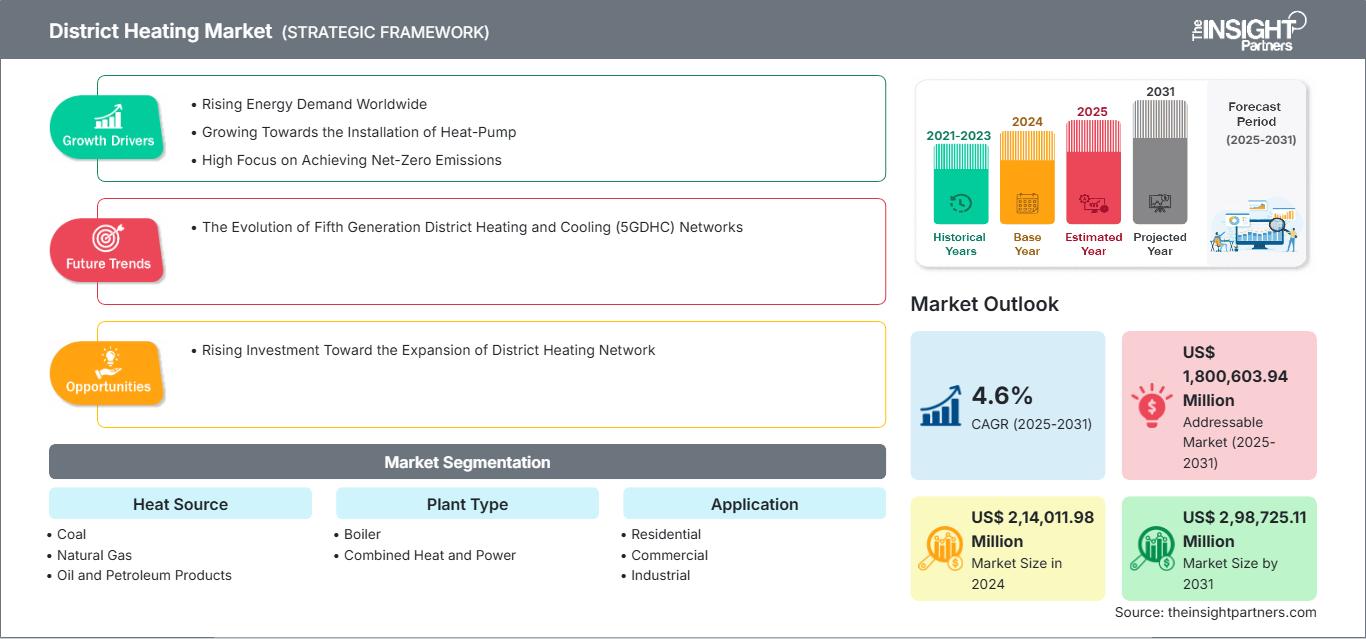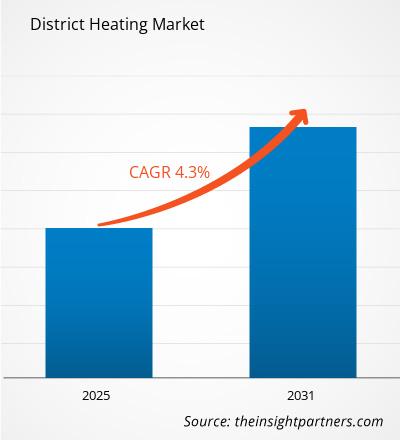地域暖房市場規模は、2024年の2,14,011.98百万米ドルから、2031年には2,98,725.11百万米ドルに達すると予想されています。市場は2025年から2031年の間に4.6%のCAGRを記録すると予測されています。世界的なエネルギー需要の増加は、今後数年間で市場に新しいトレンドをもたらす可能性があります。
地域暖房市場分析
地域暖房は、バイオ燃料、ゴミ、産業廃熱などの地元の余剰再生可能エネルギーを使用する水ベースの暖房システムです。中央エネルギープラントから熱エネルギーを生成し、複数の建物に分配します。このシステムは、エネルギープラントが蒸気または温水を生成し、断熱性の高い地下熱配管ネットワークを介して24時間年中無休で分配することをサポートします。熱エネルギーは建物の暖房システムに流れ、個々の建物にボイラーを設置する必要がなくなります。地域暖房は、エネルギー効率の向上、排出量の削減、燃料供給の柔軟性確保、建物の運用・保守の簡素化、コスト削減など、重要なインフラとして機能しています。循環型経済への移行と温室効果ガス排出量の削減において重要な役割を果たしています。地域暖房は電力網の容量を解放するだけでなく、建物や産業において化石燃料に代わる再生可能な代替燃料として活用され、設置が増加しています。
地域暖房市場概要
エネルギー需要の増加、ヒートポンプへの投資と設置の増加、そしてネットゼロ達成への強い関心が、世界中で地域暖房の需要を押し上げています。都市部におけるスマートシティプロジェクトの急増と地域暖房ネットワークの拡張に向けた投資は、市場の成長をさらに促進しています。研究開発活動の急増、産業プロセスからの廃熱利用の増加、そして第5世代地域暖房(5GDHC)ネットワークの進化は、市場における将来の成長機会を生み出すと期待されています。
地域暖房市場は、熱源、プラントの種類、用途、および地域に基づいてセグメント化されています。熱源別に見ると、市場は石炭、天然ガス、石油・石油製品、その他に分類されます。プラントの種類別に見ると、市場はボイラー、熱電併給(CHP)、その他に分類されます。用途別に見ると、地域暖房市場は住宅用、商業用、工業用に分類されます。地域別に見ると、地域暖房市場は北米とヨーロッパに分かれています。ヨーロッパが市場シェアを大きく占め、次いでアジア太平洋地域と北米が続いています。ヨーロッパの地域暖房市場は、暖房ネットワークの拡大、スマートシティプロジェクトの増加、IoTや5Gなどの先進技術の統合、政府の好ましい取り組み、地域暖房ネットワークの開発・拡張への資金提供などにより、驚異的な成長を遂げています。
要件に合わせてレポートをカスタマイズ
レポートの一部、国レベルの分析、Excelデータパックなどを含め、スタートアップ&大学向けに特別オファーや割引もご利用いただけます(無償)
地域暖房市場: 戦略的洞察

- このレポートの主要な市場動向を入手してください。この無料サンプルには、市場動向から見積もりや予測に至るまでのデータ分析が含まれます。
レポートの一部、国レベルの分析、Excelデータパックなどを含め、スタートアップ&大学向けに特別オファーや割引もご利用いただけます(無償)
地域暖房市場: 戦略的洞察

- このレポートの主要な市場動向を入手してください。この無料サンプルには、市場動向から見積もりや予測に至るまでのデータ分析が含まれます。
地域暖房市場の推進要因と機会
世界的なエネルギー需要の増加
地域暖房プラント(ボイラーや熱電併給発電など)は、断熱パイプの相互接続ネットワークを介して、住宅、商業施設、工業ビルに熱(通常は温水または蒸気の形で)を集中的に生成・供給するために使用されます。国際エネルギー機関(IEA)の2025年3月のデータによると、電力消費量の増加と再生可能エネルギーおよび天然ガスの供給増加により、エネルギー需要は急増しています。 2024年の世界エネルギー消費量は2.2%増加し、2013年から2023年の平均年間需要増加率1.3%を上回りました。2024年には、中国(4,060百万トン(mtoe))、米国(2,172 mtoe)、インド(1,135 mtoe)、ロシア(838 mtoe)、日本(391 mtoe)、ブラジル(336 mtoe)などの発展途上国やその他の新興国が、世界のエネルギー需要増加の80%以上を占めました。これらの国々のうち、中国のエネルギー消費量は2023年に約3%増加しました。地域暖房ソリューションは拡張性に優れているため、人口密度の高い都市部では信頼性の高い熱供給のために人気があります。これらのソリューションは、全体的なエネルギーの無駄を最小限に抑えながら、多数の建物に適切な量の熱を供給します。このように、持続可能なソリューションへの需要の高まりとエネルギー消費の増加により、住宅、商業、工業の各部門で地域暖房ソリューションの導入が急増しています。これらのソリューションは、エネルギーの最適な使用によって各部門をサポートし、温室効果ガスの排出削減を促進します。
地域暖房ネットワークの拡張に向けた投資の急増
都市と政府は、地域暖房ネットワークのアップグレードと複数の建物への熱エネルギーの分配に重点を置いています。政府は、熱を生成・蓄積し、都市から廃熱を収集して再利用し、エネルギー損失を削減する集中暖房システムを必要とするスマートシティを開発しています。エネルギー需要の増加と適切な暖房システムの必要性の高まりにより、地域暖房ネットワークの拡張には多額の投資が必要です。政府は、個人のエネルギー需要を満たすために、地域暖房ネットワークの拡張に投資しています。2024年9月に発表されたLean Energy Wireのデータによると、ドイツは2045年までに全住宅の3分の1に地域暖房を提供するために、毎年約50億ユーロ(55億6000万米ドル)を投資する必要があります。世界原子力協会(WNA)の2023年2月のデータによると、中国は原子力熱源プロジェクトに3億9,000万人民元(5,700万米ドル)を投資し、原子力発電所内に暖房配管網とポンプ場を建設しました。この投資により、暖房能力は970万ギガジュール(GJ)に拡大し、1,300万平方メートルの地域に暖房を供給できるようになります。これにより、100万人の住民のニーズを満たし、165万トンのCO2排出量を削減できます。地域暖房ネットワークの容量拡大は、燃料供給、メンテナンス、運用効率のコスト削減につながります。
パイプライン、発電所、配電システムなどの地域暖房システムへの投資により、より多くの家庭や企業が低コストで効率的な暖房を利用できるようになります。したがって、排出量の削減と、熱分配中のエネルギー損失を削減し、ネットワークの効率を高める地域暖房ネットワークの拡張に重点が置かれることで、市場の将来の成長機会が生まれると予想されます。
地域暖房市場レポートのセグメンテーション分析
地域暖房市場分析の導出に貢献した主要なセグメントは、熱源、プラントタイプ、およびアプリケーションです。
- 熱源の面では、市場は石炭、天然ガス、石油および石油製品などに分類されます。2024年には天然ガスセグメントが市場を支配しました。
- プラントタイプ別では、市場はボイラー、熱電併給などに分類されます。2024年には熱電併給セグメントが市場を支配しました。
- アプリケーションに基づいて、市場は住宅用、商業用、および工業用に分かれています。 2024年には住宅セグメントが市場を支配しました。
地域暖房市場シェア分析(地域別)
地域暖房市場は、北米、ヨーロッパ、アジア太平洋(APAC)、中東・アフリカ(MEA)、中南米(SAM)の5つの主要地域に分割されています。2024年にはヨーロッパが市場を支配し、アジア太平洋と北米がそれに続きました。
ヨーロッパの地域暖房市場は、ドイツ、フランス、イギリス、イタリアに分割されています。持続可能なソリューションを統合することの利点に関する政府およびハイテク企業の意識の高まりと、地域暖房ネットワークの拡張に向けた投資の増加が、これらのシステムの需要を促進しています。2025年3月のFernデータによると、デンマークのGreater Copenhagen Utility(HOFOR)は、以前はバイオマスとゴミの燃焼に基づいていた地域暖房ネットワークを電化しています。 HOFOR社は、2033年までに30億デンマーククローネ(4億1,800万米ドル)を投資し、さらに10台のヒートポンプを設置する予定です。この設備により、300MWの暖房能力が供給され、コペンハーゲンの地域暖房におけるバイオマス依存度が約3分の1に削減されます。2024年8月、デンマーク地域暖房委員会(DBDH)は、ドイツが2030年までに気候目標を達成するためには、地域暖房に少なくとも435億ユーロ(476億4,000万米ドル)を投資する必要があるというデータを発表しました。この投資は、ドイツが熱生産能力を拡大し、再生可能エネルギーを生み出し、2045年までに気候中立への移行を支援するものです。地域暖房ネットワークにヒートポンプやその他の電化システムを組み込むことで、公益事業業界は炭素排出量を削減し、暖房ネットワークの効率を向上させることができます。このように、ネットゼロ移行への投資の増加と政府の重点は、ヨーロッパの地域暖房市場の成長を促進します。
地域暖房市場地域暖房市場
予測期間全体を通して地域暖房市場に影響を与える地域的な傾向と要因については、The Insight Partnersのアナリストが詳細に説明しています。このセクションでは、北米、ヨーロッパ、アジア太平洋、中東・アフリカ、中南米における地域暖房市場のセグメントと地域についても説明します。
地域暖房市場レポートの範囲
| レポート属性 | 詳細 |
|---|---|
| の市場規模 2024 | US$ 2,14,011.98 Million |
| 市場規模別 2031 | US$ 2,98,725.11 Million |
| 世界的なCAGR (2025 - 2031) | 4.6% |
| 過去データ | 2021-2023 |
| 予測期間 | 2025-2031 |
| 対象セグメント |
By 熱源
|
| 対象地域と国 | 北米
|
| 市場リーダーと主要企業の概要 |
|
地域暖房市場のプレーヤー密度:ビジネスダイナミクスへの影響を理解する
地域暖房市場は、消費者の嗜好の変化、技術の進歩、製品の利点に対する認知度の高まりといった要因により、エンドユーザーの需要が高まり、急速に成長しています。需要の増加に伴い、企業は提供内容を拡大し、消費者のニーズを満たすために革新を起こし、新たなトレンドを活用しており、これが市場の成長をさらに促進しています。

- 入手 地域暖房市場 主要プレーヤーの概要
地域暖房市場のニュースと最近の動向
地域暖房市場は、主要な企業出版物、協会データ、データベースなどの一次調査と二次調査後の定性的および定量的データを収集することで評価されます。地域暖房市場における主要な動向のいくつかを以下に示します。
- Fortumは、シミュレーションの専門知識を活用して、フィンランドのテクノロジー企業Steady Energyの地域暖房用原子炉の開発を支援することに合意しました。目標は、Aprosソフトウェアを使用して、Steady EnergyのLDR-50原子炉の包括的なデジタルツインを作成することです。(出典:Fortum、プレスリリース、2025年3月)
- フランスの公益企業Engie SA(EPA:ENGI)の一部門であるEngie Polskaは、2025年末までにポーランドの暖房プラントで石炭を段階的に廃止し、バイオマス、天然ガス、または廃熱に切り替えることを決定しました。ポーランド北部の町スルプスクにある同社の工場は、2026年までに、再生可能エネルギー、廃熱、高効率コージェネレーションによって熱の80%を賄う予定です。この目標達成のため、同社は石炭ボイラーをバイオマスボイラーに転換し、処理済み下水廃熱のポテンシャルを活用するヒートポンプを設置しています。 (出典:Engie SA、プレスリリース、2025年3月)
地域暖房市場レポートの対象範囲と成果物
「地域暖房市場の規模と予測(2021~2031年)」では、以下の分野を網羅した詳細な市場分析を提供しています。
- 調査対象に含まれるすべての主要市場セグメントにおける、世界、地域、国レベルでの地域暖房市場の規模と予測
- 地域暖房市場の動向、および推進要因、制約、主要な機会などの市場動向
- 詳細なPEST分析とSWOT分析
- 主要な市場動向、世界および地域の枠組み、主要プレーヤー、規制、および最近の市場動向を網羅した地域暖房市場分析
- 市場集中、ヒートマップ分析、主要プレーヤー、および地域暖房市場の最近の動向を網羅した業界動向と競争分析
- 詳細な企業プロファイル
- 過去2年間の分析、基準年、CAGRによる予測(7年間)
- PEST分析とSWOT分析
- 市場規模価値/数量 - 世界、地域、国
- 業界と競争環境
- Excel データセット
最新レポート
関連レポート
お客様の声
購入理由
- 情報に基づいた意思決定
- 市場動向の理解
- 競合分析
- 顧客インサイト
- 市場予測
- リスク軽減
- 戦略計画
- 投資の正当性
- 新興市場の特定
- マーケティング戦略の強化
- 業務効率の向上
- 規制動向への対応




















 無料サンプルを入手 - 地域暖房市場
無料サンプルを入手 - 地域暖房市場